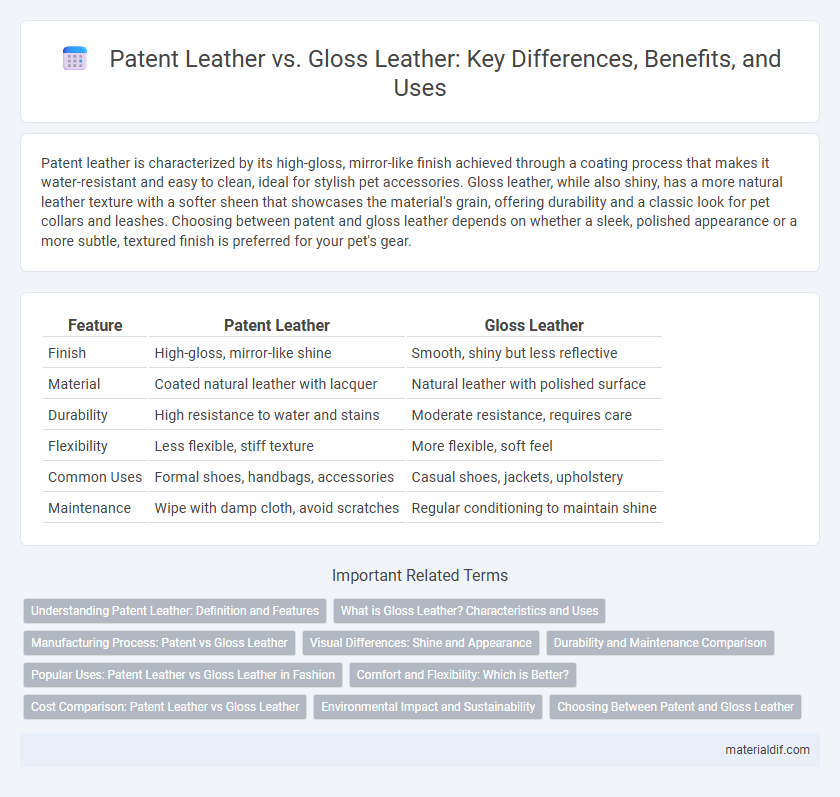Patent leather is characterized by its high-gloss, mirror-like finish achieved through a coating process that makes it water-resistant and easy to clean, ideal for stylish pet accessories. Gloss leather, while also shiny, has a more natural leather texture with a softer sheen that showcases the material's grain, offering durability and a classic look for pet collars and leashes. Choosing between patent and gloss leather depends on whether a sleek, polished appearance or a more subtle, textured finish is preferred for your pet's gear.
Table of Comparison
| Feature | Patent Leather | Gloss Leather |
|---|---|---|
| Finish | High-gloss, mirror-like shine | Smooth, shiny but less reflective |
| Material | Coated natural leather with lacquer | Natural leather with polished surface |
| Durability | High resistance to water and stains | Moderate resistance, requires care |
| Flexibility | Less flexible, stiff texture | More flexible, soft feel |
| Common Uses | Formal shoes, handbags, accessories | Casual shoes, jackets, upholstery |
| Maintenance | Wipe with damp cloth, avoid scratches | Regular conditioning to maintain shine |
Understanding Patent Leather: Definition and Features
Patent leather is a type of leather coated with a high-gloss finish made from lacquer or varnish, offering a shiny, mirror-like surface that is water-resistant and easy to clean. Its defining features include a smooth, reflective appearance and durability, often used in formal footwear, handbags, and accessories. Unlike gloss leather, which refers to any leather with a shiny surface, patent leather specifically undergoes a finishing process that creates its distinctive, polished look.
What is Gloss Leather? Characteristics and Uses
Gloss leather, also known as high-gloss or lacquered leather, is characterized by its shiny, reflective surface achieved through a special coating process that enhances durability and visual appeal. It is commonly used in fashion items such as shoes, handbags, and accessories due to its eye-catching finish and resistance to water and stains. Gloss leather's smooth texture and polished appearance make it ideal for formal and stylish products requiring both aesthetic quality and practical wearability.
Manufacturing Process: Patent vs Gloss Leather
Patent leather undergoes a coating process where a high-gloss polyurethane or lacquer is applied to the leather's surface, creating its characteristic shiny, reflective finish. Gloss leather, by contrast, achieves its sheen through polishing and finishing techniques without an additional coating layer, maintaining a more natural leather texture with a subtle shine. The manufacturing of patent leather involves multiple layers of coating and curing, while gloss leather relies on mechanical buffing and wax treatments to enhance surface luster.
Visual Differences: Shine and Appearance
Patent leather features a high-gloss finish achieved through a coating process that gives it a mirror-like shine, making it visually striking and formal. Gloss leather, while also shiny, has a subtler sheen with a more natural texture visible beneath the surface, creating a less reflective and more understated appearance. The shine of patent leather tends to be uniform and smooth, whereas gloss leather reflects light softly, highlighting the grain and depth of the leather.
Durability and Maintenance Comparison
Patent leather, known for its high-gloss finish achieved through a lacquer coating, offers moderate durability but requires careful maintenance to prevent cracking and discoloration over time. Gloss leather, which features a polished but less sealed surface, tends to be more breathable and less prone to surface damage, although it may dull faster without regular conditioning. Both types benefit from avoiding excessive moisture and direct sunlight to extend lifespan, with patent leather demanding specialized cleaning products to maintain its shine.
Popular Uses: Patent Leather vs Gloss Leather in Fashion
Patent leather is widely favored in fashion for its high-gloss finish, making it a popular choice for formal shoes, handbags, and accessories that require a sleek and polished appearance. Gloss leather, often less reflective but still shiny, is commonly used in apparel such as jackets, skirts, and boots, offering a sophisticated yet subtle sheen ideal for both casual and semi-formal wear. Both materials enhance the aesthetic appeal of fashion items but serve different stylistic purposes due to their distinct finishes and durability characteristics.
Comfort and Flexibility: Which is Better?
Patent leather features a stiff and glossy finish due to its plastic coating, which limits breathability and reduces comfort during extended wear. Gloss leather, typically a polished version of smooth leather, maintains more natural flexibility and allows better air circulation, enhancing comfort. For long-term wear where comfort and flexibility are priorities, gloss leather generally outperforms patent leather.
Cost Comparison: Patent Leather vs Gloss Leather
Patent leather typically costs more than gloss leather due to its complex manufacturing process involving a high-gloss lacquer finish that requires extra labor and materials. Gloss leather, while shiny, is generally produced with a simpler coating, making it more affordable and accessible for mass-market products. The price difference reflects durability and aesthetic qualities, with patent leather favored for premium fashion items.
Environmental Impact and Sustainability
Patent leather undergoes a heavy chemical coating process involving solvents and plastics, resulting in lower biodegradability and increased environmental pollution. Gloss leather, often treated with eco-friendlier coatings or natural oils, tends to have a reduced carbon footprint and better sustainability profile. Choosing gloss leather supports more environmentally responsible production methods compared to the synthetic-heavy treatments required for patent leather.
Choosing Between Patent and Gloss Leather
Choosing between patent leather and gloss leather depends on the desired durability and shine level; patent leather features a high-gloss, plastic-coated finish making it water-resistant and ideal for formal occasions, while gloss leather offers a natural shine with enhanced breathability suitable for everyday wear. Patent leather requires less maintenance but is more prone to cracking over time, whereas gloss leather can be conditioned to maintain suppleness and extend the lifespan. Considering factors such as climate, frequency of use, and outfit coordination can help determine the best leather type for your wardrobe needs.
Patent Leather vs Gloss Leather Infographic

 materialdif.com
materialdif.com